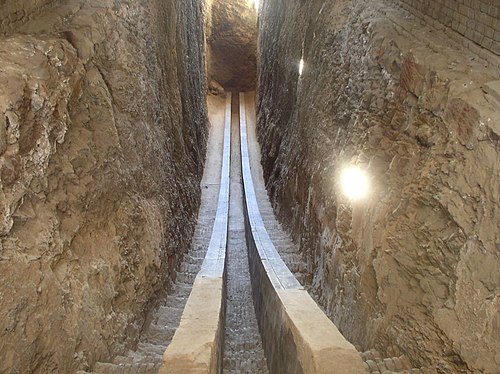

Amural instrument is anangle measuring instrument mounted on or built into a wall. For astronomical purposes, these walls were oriented so they lie precisely on themeridian. A mural instrument that measured angles from 0 to 90 degrees was called amural quadrant. They were utilized as astronomical devices inancient Egypt andancient Greece.Edmond Halley, due to the lack of an assistant and only one vertical wire in histransit, confined himself to the use of a mural quadrant built byGeorge Graham after its erection in 1725 at theRoyal Observatory, Greenwich.Bradley's first observation with that quadrant was made on 15 June 1742.[1]
The mural quadrant has been called the "quintessential instrument" of 18th century (i.e. 1700s) observatories.[2] It rose to prominence in the field ofpositional astronomy at this time.[2]

Many older mural quadrants have been constructed by marking directly on the wall surfaces. More recent instruments were made with a frame that was constructed with precision and mounted permanently on the wall.
The arc is marked with divisions, almost always indegrees and fractions of a degree. In the oldest instruments, an indicator is placed at the centre of thearc. An observer can move a device with a second indicator along the arc until the line of sight from the movable device's indicator through the indicator at the centre of the arc aligns with theastronomical object. The angle is then read, yielding theelevation or altitude of the object. In smaller instruments, analidade could be used. More modern mural instruments would use atelescope with areticle eyepiece to observe the object.
Many mural quadrants were constructed, giving the observer the ability to measure a 90° range ofelevation. There were alsomural sextants that read 60°.
Mural quadrants of the 17th century were noted for their expense, with Flamsteed's 1689 quadrant costing £120 (equivalent to £27,488 in 2023), and Edmund Halley's 1725 quadrant which cost over £200 (equivalent to £37,619 in 2023).[2] The large fixed quadrants were more expensive than a typical portable quadrant, with a Bird 2-foot quadrant costing 70guineas or £73.50 (equivalent to £13,825 in 2023).[2]
In order to measure the position of, for example, a star, the observer needs asidereal clock in addition to the mural instrument. With the clock measuring time, a star of interest is observed with the instrument until it crosses an indicator showing that it istransiting the meridian. At this instant, the time on the clock is recorded as well as the angular elevation of the star. This yields the position in the coordinates of the instrument. If the instrument's arc is not marked relative to the celestial equator, then the elevation is corrected for the difference, resulting in the star'sdeclination. If the sidereal clock is precisely synchronized with the stars, the time yields theright ascension directly.[3]

 Media related toMural instrument at Wikimedia Commons
Media related toMural instrument at Wikimedia Commons